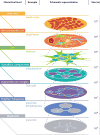Current technical approaches to brain energy metabolism
- PMID: 29110344
- PMCID: PMC5903992
- DOI: 10.1002/glia.23248
Current technical approaches to brain energy metabolism
Abstract
Neuroscience is a technology-driven discipline and brain energy metabolism is no exception. Once satisfied with mapping metabolic pathways at organ level, we are now looking to learn what it is exactly that metabolic enzymes and transporters do and when, where do they reside, how are they regulated, and how do they relate to the specific functions of neurons, glial cells, and their subcellular domains and organelles, in different areas of the brain. Moreover, we aim to quantify the fluxes of metabolites within and between cells. Energy metabolism is not just a necessity for proper cell function and viability but plays specific roles in higher brain functions such as memory processing and behavior, whose mechanisms need to be understood at all hierarchical levels, from isolated proteins to whole subjects, in both health and disease. To this aim, the field takes advantage of diverse disciplines including anatomy, histology, physiology, biochemistry, bioenergetics, cellular biology, molecular biology, developmental biology, neurology, and mathematical modeling. This article presents a well-referenced synopsis of the technical side of brain energy metabolism research. Detail and jargon are avoided whenever possible and emphasis is given to comparative strengths, limitations, and weaknesses, information that is often not available in regular articles.
Keywords: in vitro; in vivo; organization level; spatio-temporal resolution.
© 2017 Wiley Periodicals, Inc.
Figures



References
-
- Adan A, Kiraz Y, Baran Y. Cell Proliferation and Cytotoxicity Assays. Curr Pharm Biotechnol. 2016;17:1213–1221. - PubMed
-
- Akerboom J, Chen TW, Wardill TJ, Tian L, Marvin JS, Mutlu S, Calderon NC, Esposti F, Borghuis BG, Sun XR, Gordus A, Orger MB, Portugues R, Engert F, Macklin JJ, Filosa A, Aggarwal A, Kerr RA, Takagi R, Kracun S, Shigetomi E, Khakh BS, Baier H, Lagnado L, Wang SS, Bargmann CI, Kimmel BE, Jayaraman V, Svoboda K, Kim DS, Schreiter ER, Looger LL. Optimization of a GCaMP calcium indicator for neural activity imaging. J Neurosci. 2012;32:13819–13840. - PMC - PubMed
-
- Almeida A, Moncada S, Bolanos JP. Nitric oxide switches on glycolysis through the AMP protein kinase and 6-phosphofructo-2-kinase pathway. Nat Cell Biol. 2004;6:45–51. - PubMed
-
- Aubert A, Costalat R. Compartmentalization of brain energy metabolism between glia and neurons: insights from mathematical modeling. Glia. 2007;55:1272–1279. - PubMed
-
- Auld DS, Inglese J. Interferences with Luciferase Reporter Enzymes 2004 - PubMed
Publication types
MeSH terms
Grants and funding
LinkOut - more resources
Full Text Sources
Other Literature Sources

